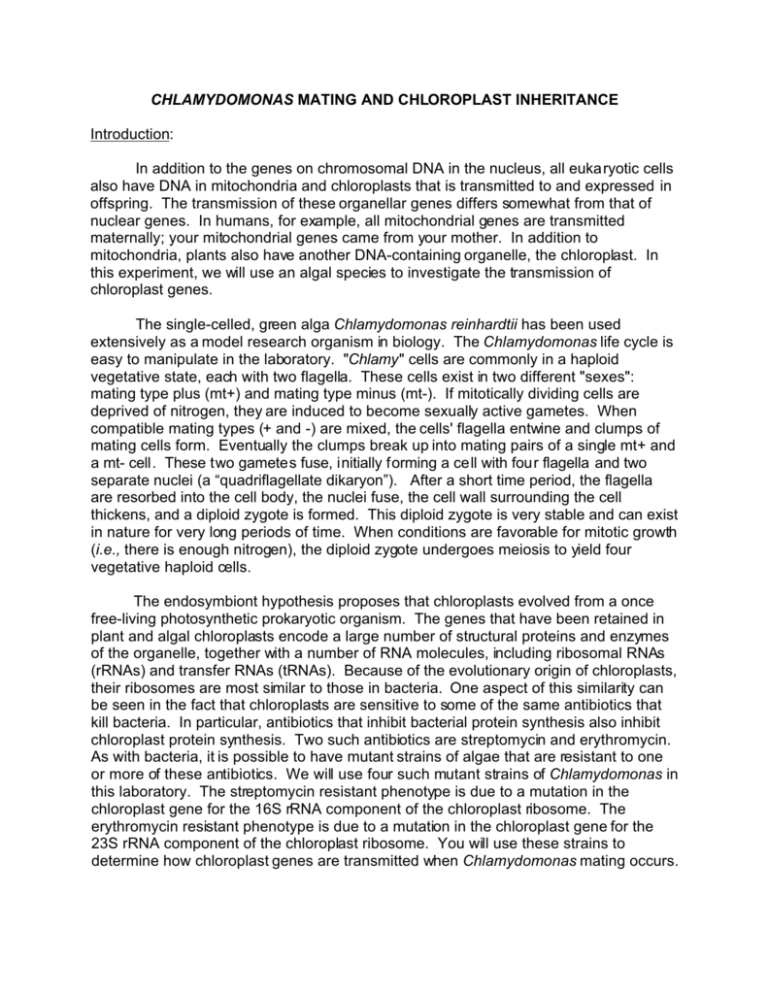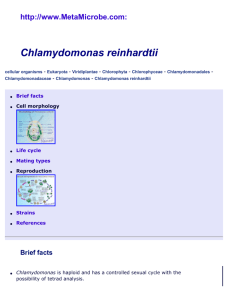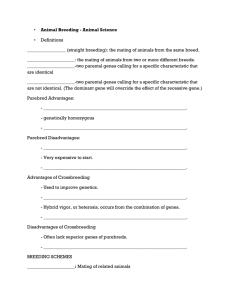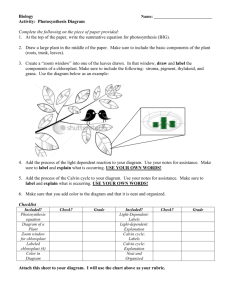CHLAMYDOMONAS MATING AND CHLOROPLAST INHERITANCE
advertisement

CHLAMYDOMONAS MATING AND CHLOROPLAST INHERITANCE Introduction: In addition to the genes on chromosomal DNA in the nucleus, all eukaryotic cells also have DNA in mitochondria and chloroplasts that is transmitted to and expressed in offspring. The transmission of these organellar genes differs somewhat from that of nuclear genes. In humans, for example, all mitochondrial genes are transmitted maternally; your mitochondrial genes came from your mother. In addition to mitochondria, plants also have another DNA-containing organelle, the chloroplast. In this experiment, we will use an algal species to investigate the transmission of chloroplast genes. The single-celled, green alga Chlamydomonas reinhardtii has been used extensively as a model research organism in biology. The Chlamydomonas life cycle is easy to manipulate in the laboratory. "Chlamy" cells are commonly in a haploid vegetative state, each with two flagella. These cells exist in two different "sexes": mating type plus (mt+) and mating type minus (mt-). If mitotically dividing cells are deprived of nitrogen, they are induced to become sexually active gametes. When compatible mating types (+ and -) are mixed, the cells' flagella entwine and clumps of mating cells form. Eventually the clumps break up into mating pairs of a single mt+ and a mt- cell. These two gametes fuse, initially forming a cell with four flagella and two separate nuclei (a “quadriflagellate dikaryon”). After a short time period, the flagella are resorbed into the cell body, the nuclei fuse, the cell wall surrounding the cell thickens, and a diploid zygote is formed. This diploid zygote is very stable and can exist in nature for very long periods of time. When conditions are favorable for mitotic growth (i.e., there is enough nitrogen), the diploid zygote undergoes meiosis to yield four vegetative haploid cells. The endosymbiont hypothesis proposes that chloroplasts evolved from a once free-living photosynthetic prokaryotic organism. The genes that have been retained in plant and algal chloroplasts encode a large number of structural proteins and enzymes of the organelle, together with a number of RNA molecules, including ribosomal RNAs (rRNAs) and transfer RNAs (tRNAs). Because of the evolutionary origin of chloroplasts, their ribosomes are most similar to those in bacteria. One aspect of this similarity can be seen in the fact that chloroplasts are sensitive to some of the same antibiotics that kill bacteria. In particular, antibiotics that inhibit bacterial protein synthesis also inhibit chloroplast protein synthesis. Two such antibiotics are streptomycin and erythromycin. As with bacteria, it is possible to have mutant strains of algae that are resistant to one or more of these antibiotics. We will use four such mutant strains of Chlamydomonas in this laboratory. The streptomycin resistant phenotype is due to a mutation in the chloroplast gene for the 16S rRNA component of the chloroplast ribosome. The erythromycin resistant phenotype is due to a mutation in the chloroplast gene for the 23S rRNA component of the chloroplast ribosome. You will use these strains to determine how chloroplast genes are transmitted when Chlamydomonas mating occurs. Protocol: FIRST WEEK A. Basic Microscopic Observations: 1) Vegetative cells: These cells divide asexually and have been growing in a medium containing nitrogen. They are generally larger than gamete cells and swim at a slower rate. 2) Gametes: These cells have been grown in a medium lacking nitrogen and are competent to reproduce sexually. They are smaller and livelier than vegetative cells. 3) Mixed sexual mt+ and mt- gametes: Observe the frantic swimming and clumping behaviors exhibited by mixed gametic cells. Add a drop of iodine to a sample to kill the cells. The iodine will coat the cells, making the flagella visible. The immediate product of mating (the quadriflagellate dikaryon) is larger than the unmated cells and has four rather than two flagella that are visible under the microscope. B. Begin Main Experimental Procedure: To investigate the inheritance of chloroplast genes in Chlamydomonas, we will analyze two matings involving a total of four strains, as indicated below: mt+, strr, erys X mt-, strs, eryr CC-118 CC-67 And mt+, strs, eryr X mt-, strr, erys CC-333 CC-119 (note: strr means that the cells are resistant to streptomycin and strs means that cells are streptomycin sensitive. Strr cells will survive with streptomycin present, but strs cells will die.) 1. Plating Mating Mixture Spread approximately 1 ml of each mating mixture onto a non-selective, complete medium plate (one plate for each cross). Use a Pasteur pipette to inoculate in a line across the center of the plate. Then use the tip of the pipette to distribute the liquid in a zig-zag pattern across the surface of the plates. Place the plates under the grow-light. Zygotes will form in the light, but then must spend days in the dark to "mature" and develop the thick, protective cell wall around them. After 12-16 hours in the light, your plates will be collected and stored in the dark for 5 to 6 days. After 6 days of incubation, each plate will be inverted over chloroform (the fumes will kill all unmated cells but will not harm the thick-walled zygotes). The plates will then be returned to the light for 24 hrs to induce meiosis. 2. Plating Parental Cells (control) You will be provided with four complete medium plates: (no drug, erythromycin, streptomycin, and both antibiotics). Divide each plate into quadrants. Plate the four types of unmated gametes by putting one drop in each quadrant of each of the four plates. Incubate under light so you will be able to determine the growth characteristics of these parental cell types. SECOND WEEK 1. Harvesting and Plating Zygotes: Using a Pasteur pipette, put approximately 1 ml of medium onto the surface of each of the two mating plates from last week. Gently scrape the cells from the surface and aspirate them using a Pasteur pipette (the fluid should have a definite green color at this point) and distribute the suspended cells equally among the four types of complete medium plates: (no drug; erythromycin; streptomycin; and both antibiotics). Incubate the plates under a grow light for at least several days, until you can unambiguously determine whether growth has occurred. 2. Analysis of Results: After at least several days, observe the growth patterns obtained for the plated zygotes and for the plated parental cells (the control plates from the first week). As described in the introduction, we know that the streptomycin resistance and erythromycin resistance phenotypes are due to mutant alleles for two different chloroplast genes. The matings were done such that these mutant alleles were transmitted from either a mating type plus or a mating type minus parental cell. From this information, combined with your results, what can you conclude about the transmission of chloroplast genes in this alga? Do both parents transmit chloroplast genes? If only one parent does, which one? Propose a reasonable model to account for the transmission pattern for chloroplast genes. For your lab report, draw a very clear diagram that shows how chloroplast gene transmission occurs in Chlamydomonas.







